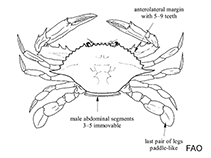Callinectes larvatus Ordway, 1863
Masked swimcrab| Native range | All suitable habitat | Point map | Year 2050 |

|
| This map was computer-generated and has not yet been reviewed. |
| Callinectes larvatus AquaMaps Data sources: GBIF OBIS |
Upload your photos
Google image | No image available for this species;
drawing shows typical species in Portunidae.
Google image | No image available for this species;
drawing shows typical species in Portunidae.
Classification / Names Common names | Synonyms | CoL | ITIS | WoRMS
Malacostraca | Decapoda | Portunidae
Environment: milieu / climate zone / depth range / distribution range Ecology
Benthopelagic; depth range 0 - 25 m (Ref. 97531), usually 0 - 5 m. Tropical
Distribution Countries | FAO areas | Ecosystems | Occurrences | Introductions
Western Atlantic: USA to Brazil.
Length at first maturity / Size / Weight / Age
Maturity: Lm ? range ? - ? cm Max length : 14.2 cm WD male/unsexed; (Ref. 367); 9.5 cm WD (female)
Short description Morphology
Carapace slightly more than twice as broad as long; 9 teeth on arched anterolateral margin (outer orbital tooth and strong lateral spine included), second to eighth usually trending forward, without shoulders, anterior margins concave except first 2; front (excluding outer orbital angles) bearing 4 teeth, inner pair small but definitely formed. Anterior half of convex dorsal surface coarsely granulate, variably finer and more numerous granules on posterior on posterior part and in transverse lines; central trapezoidal (metagastric) area short and wide (anterior width about 2.4 times, posterior width about 1.5 times length). Pincers dissimilar, ridged longitudinally, fingers compressed but broadened dorsoventrally producing pointed spatulate shape; fifth legs flattened in form fifth legs flattened in form of paddles. Male with T-shaped abdomen reaching slightly beyond suture between thoracic sternites 4 and 5, sixth segment nearly parallel-sided but broadened proximally; first pleopods short, reaching about midlength of sternite 7, approximately each other or occasionally overlapping at level of abrupt curve beyond which short terminal part tapers to rather sharp tip; armed with minute scattered retrogressive spinules distally. Color: carapace brown with areas of bluish black. Chelae brown above; fingers dark on external face except for tips and proximal portion, internal face dark in distal 2/3; dark color of fingers retained in preservation.
Life cycle and mating behavior Maturity | Reproduction | Spawning | Eggs | Fecundity | Larvae
Members of the order Decapoda are mostly gonochoric. Mating behavior: Precopulatory courtship ritual is common (through olfactory and tactile cues); usually indirect sperm transfer.
Main reference
References | Coordinator | Collaborators
Tavares, M. 2003. (Ref. 367)
IUCN Red List Status (Ref. 130435: Version 2024-1)
CITES status (Ref. 108899)
Not Evaluated
CMS (Ref. 116361)
Not Evaluated
Threat to humans
Human uses
Fisheries: minor commercial
| FishSource |
Tools
More information
Trophic Ecology
Food items
Diet
Food consumption
Ration
Predators
Diet
Food consumption
Ration
Predators
Ecology
Population dynamics
Growth
Age/Size
Length-weight
Length-length
Length-frequencies
Mass conversion
Recruitment
Abundance
Age/Size
Length-weight
Length-length
Length-frequencies
Mass conversion
Recruitment
Abundance
Life cycle
Distribution
Human Related
Aquaculture profile
Stamps, Coins Misc.
Stamps, Coins Misc.
Outreach
References
Internet sources
BHL | BOLD Systems | CISTI | DiscoverLife | FAO(Publication : search) | Fishipedia | GenBank (genome, nucleotide) | GloBI | Gomexsi | Google Books | Google Scholar | Google | PubMed | Tree of Life | Wikipedia (Go, Search) | Zoological Record
Estimates based on models
Preferred temperature
(Ref. 115969): 26.3 - 28.2, mean 27.4 (based on 546 cells).



